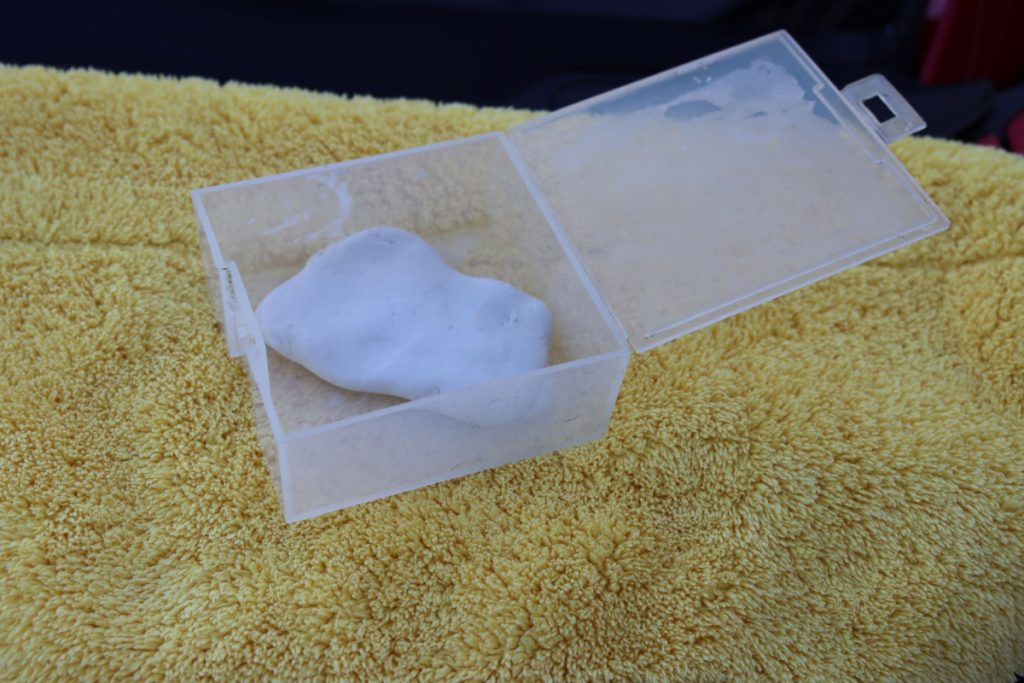If you’re planning on claying your car and you have a wax, sealant or coating on the surface, then you’ll need to know the effect of the clay before you begin. In this article, I’ll take you through everything you need to know about the effects of clay bars on waxes, sealants and coatings. So let’s get started!
The Quick Answer
Clay bars are abrasive so in most cases, will remove waxes and sealants. Sometimes, clay will not remove very durable sealants and are unlikely to remove ceramic coatings which require machine polishing to be properly removed.

How do Clay Bars Work?
Clay bars are abrasive. The idea, is that they remove contaminants like water spots, tree sap, iron fallout and anything else that makes the paintwork feel rough. They do this by either pulling the contaminants out of the paintwork if they’re embedded, or by shaving them down if they’re sitting on top of the paint.
Since, they’re abrasive, they will inevitably have an impact on your paint protection layer, be that a wax, sealant or ceramic coating.
Effect of Clay Bars on Waxes, Sealants and Coatings
If you have an old wax or sealant on the paintwork and you clay the car, then it is very likely that the clay will abrade away this layer of paint protection to leave you with a fresh, bare paint surface.
However, it’s not always the case and will depend on a few of things.
- How durable and tough the wax, sealant or coating is.
- How long the paint protection has been on the car.
- The type of clay you’re using.
The first two points are pretty self-explanatory. In most cases, the clay will remove sealants and waxes, but if you’re using something exceptionally durable, like a ceramic coating, then the clay will likely not be able to completely remove it. In this case, you’ll also need to machine polish the car.
There are also different “grades” of clay. Some clays can be described as “soft” meaning they aren’t very abrasive. The advantage of this, is that they’re less likely to cause swirl marks and marring, however they’re less able to remove contaminants and waxes/ sealants fully.
Some clays are “harder” or “firmer” which means they’re more abrasive. These types of clay will have an easier time removing waxes, sealants and coatings. A lot of car detailing brands will have different grades of clay to choose from.
Ceramic Coatings
A clay bar, mitt, or cloth should not be used on a ceramic coated car because it can break down the coating, and cause swirl marks. You can use an iron fallout and tar remover instead to safely remove contamination without using clay.
Take a look at this article I’ve written on coatings vs clay bars to find out more.
Is It Best to Remove the Wax Before Claying?
Removing your car’s wax, sealant or coating prior to claying will help the clay bar fully remove the contaminants without being impaired by the paint protection layer. However, in most cases the clay will be capable of removing both the wax/ sealant/ coating, as well as the contaminants.
For optimal results, I recommend using a wax-stripping shampoo prior to claying. This will help the clay bar to be more effective at removing the contaminants on the paintwork.
Check out my guide on 5 different ways to remove old waxes and sealants.
Should I Wax Again After Claying?
It is important to apply another layer of paint protection, in the form of a wax, sealant or coating after using a clay bar in order to protect the paintwork properly. In most cases, the clay bar will have completely removed any previous protection, or at least impaired it, so applying a fresh layer is essential.
More Frequently Asked Questions
Don’t worry if you’ve still got some more questions. Here are the answers to some of the most frequently asked questions related to claying and waxes.
What do clay bars remove?
Clay bars remove contaminants, which essentially bond to the paintwork and cannot be removed by just washing. These include water spots, tar, iron fallout, tree sap, and old waxes and sealants.
Does a clay bar remove clear coat?
Clay bars are abrasive, so can mar/ scratch the clear coat but will not remove an entire layer especially if used without proper lubrication.
Make sure you check out my guide to the best clay bar lubricants to make sure you choose the right option to minimise any marring and swirls that may be inflicted by the clay.
Take a look at this article I’ve written on how to clay bar a car without damaging the clear coat to learn more about this topic.
Should I wash my car after claying?
It is good practice to wash a car after using a clay bar in order to remove any loose contaminants that did not stick to the clay. Use a fresh bucket of car shampoo and a clean wash mitt to wash the car after claying.
Make sure you check out my complete guide to claying to learn some essential tips to make the process safer and more effective.
Thanks for reading! I hope you’ve found this article helpful. Don’t forget to check out the rest of the website to learn everything you need to know about car detailing.

